
Milos, Greece: Secret Greek Island Of The Summer
- Uncategorized
-
Aug 15
- Share post

Among the islands of the Cyclades, even of the world, Milos stands luminously in the history of art. Not because a great artist came from here, or was inspired by it, but rather because of a chance discovery in its soil.
On 8 April 1820 an ensign in the French navy and amateur archaeologist named Olivier Voutier went ashore to dig in the vicinity of the island’s ancient theatre. He noticed a farmer a few paces away pause in his labours, peer through a gap in an old wall, register an expression of surprise, and then turn away. Voutier was curious. He went to the wall to have a look. In the recess within he saw a shape, the naked torso of a woman, carved in marble, lying on her side. He paid the farmer to help him dig it out. Torso was followed by draped legs, a wedge from the hip, plinth, foot and other fragments. Wedge and torso were stacked on the legs and in the afternoon light what would become known as the Venus de Milo stood before Ensign Voutier.
How the gouged, dusty, battered figure, arm-, foot- and noseless, became the entrancing star of the Louvre is a tale of disputatious and counterfeit scholarship, lies, cover-ups, vanity and restorations both inept and artful. Above all it is a tale of one-upmanship among imperial nations, for not long before the Venus arrived in Paris, the British government acquired sculptures taken from the Parthenon by Lord Elgin, who had refused a higher bid from Napoleon, and installed them in the British Museum, making it the pre-eminent institution of its kind in the world. The directors of the Louvre were piqued. The Venus would be an eloquent riposte, but there was a problem. It would only be important enough if she was from the Classical Age and evidence suggested that she dated from the later, more prosaic Hellenistic period. Patriotic scholars were deployed. It was as if the empire depended upon it. The scholars delivered the verdict expected of them, the Germans were suspicious, war was waged in academic journals, evidence was destroyed, veils drawn and ambiguity allowed to prevail.
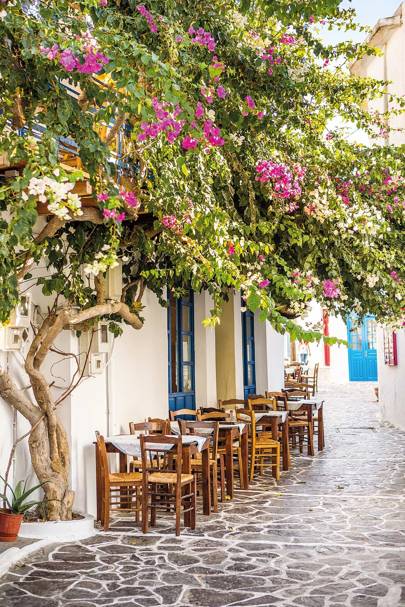
Street in Plaka, Milos
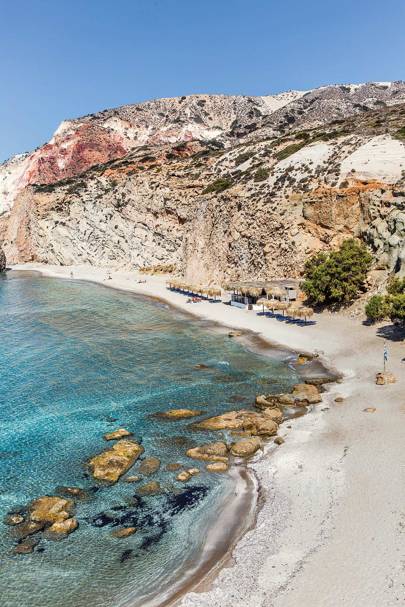
Firiplaka beach, Milos
Once displayed, the multitudes thronged to see her, as they still do. Whatever her age, she paid back for the attention given her with her mystique, serenity, timelessness and ease with her own beauty. The life force in the Venus’s cocked leg, her gaze and slight twist of torso as the robe slips from her hip make her godliness proximate, earthy, even human. She’s been salt cellar, lamp, promoter of Mercedes-Benz cars and subject of a song by Chuck Berry. The artists Rodin, Dalí, Max Ernst and Jim Dine have all remade the Venus according to their own visions. When she travelled to Japan, 100,000 people went to the harbour to greet her.
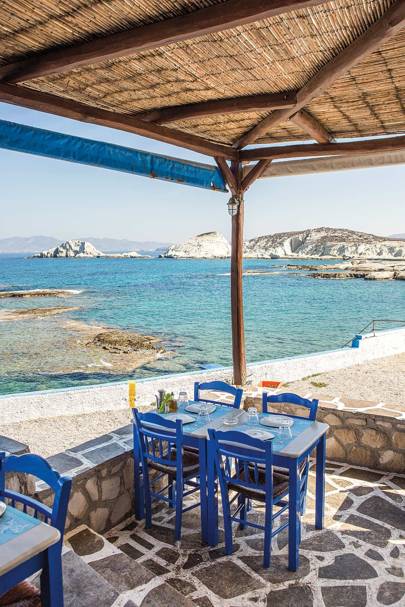
The terrace at Medousa restaurant, Milos
Many of those involved in the struggle to get the Venus off the island and on her way to Paris were scornful of the place that had been her home. It was a barbaric outpost, a source of resentment. A Texan named Gregory Curtis who wrote a book about the Venus declared that when tourists leave Milos, it ‘returns to its unlovely self – dull, remote, harsh’. In the travel marketplace it tends to be overlooked in favour of its more glamorous neighbours: dramatic Santorini, gastronomical Sifnos, hedonistic Mykonos, the chic and diminutive Folegandros. I simply don’t get it. I first went to Milos in 2008 and it has remained the place in the Aegean to which I most want to return. It is an astonishing spectacle of colour and form. It has the most varied and impressive beaches I’ve seen. The house I’d rented back then had delighted me more than any other place I’d stayed in – whether villa, hunting lodge, five-star hotel, riverboat, treehouse, baronial hall or tent.
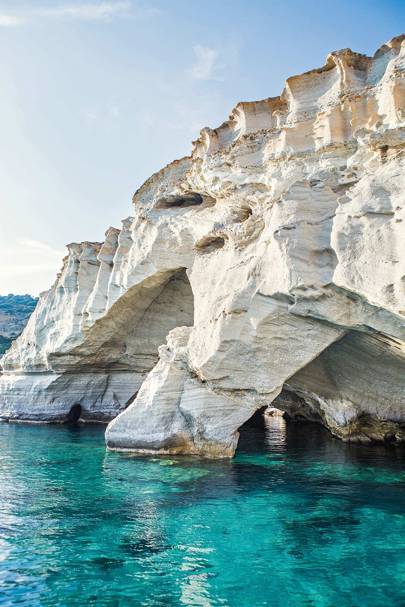
Caves at Kleftiko beach, Milos
It was at the end of a precipitous dirt track among a crescent of half a dozen similar buildings pressed between cliff and the water of a small bay. This tiny and isolated assemblage is known as Skinopi. It has an even tinier cousin to the north, Little Skinopi, accessible only by sea. The house was not at inception a house, but rather a place known as a syrma, where a fisherman could park his boat in a water-level garage and have a meal and a nap upstairs before an early start. I had not seen such properties anywhere else in Greece, but in Milos they are in rock-backed villages around the cape on the eastern side of the immense harbour – at Klima, Areti, Fourkovouni, Firopotamos and Mandrakia. Mine had a bathroom the size of a dining table. There was no hot water. The furniture was made of plastic. Cartoons once meant to entertain the owner-fisherman’s children, or perhaps grandchildren, provided the decoration. Donald Duck featured, as I recall. There is no doubt that many would not wish to pass a night there. Even two women in nearby Tripiti, from whom I’d asked directions, threw up their hands and screeched ‘Skinopi!’ as if it were a madness in itself. I could have done with hot water, more pleasing furniture and no Donald Duck. But it had two balconies, one on top of the other, looking right over the Aegean. The sensation of water was thrillingly intense, the sound and aroma of it at night, the dance of light on it through the day. You were unencumbered. You could do whatever you wanted. There was no one else in Skinopi at all.
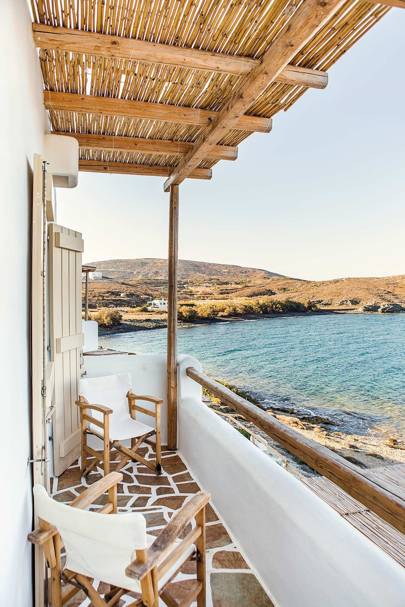
The view from a balcony at Salt Hotel, Milos
Milos’s colours and wealth and the shaping of its history derive from its having been flung out of the sea by volcanoes that blew around two million years ago, the principal crater forming one of the largest harbours in the Aegean at Adamas (‘diamond’ in Greek). Hot springs praised by Hippocrates still bubble up around the island. Obsidian was its first star mineral, the traders at Phylacopi selling it to the Minoans for weapons and razors. Pliny wrote of alum that rivalled Egypt’s and declared that it had the most abundant supply of sulphur in the known world. At Theorychia you can see the haunting remains of a sulphur mine clinging to a cliff striped in yellow, rusting wagons still on the tracks, the water crystal clear, the beach stones like a painter’s palette with the colours running together, an odour of rotten eggs in the air. An 11,000-year-old mining industry still thrives through the collection of kaolin, baryte, pozzolan and bentonite. All this geological munificence has produced crystals, solidified volcanic ash and streaks of oxidised metals that make you feel you are in a place that has been dreamed up rather than naturally evolved.
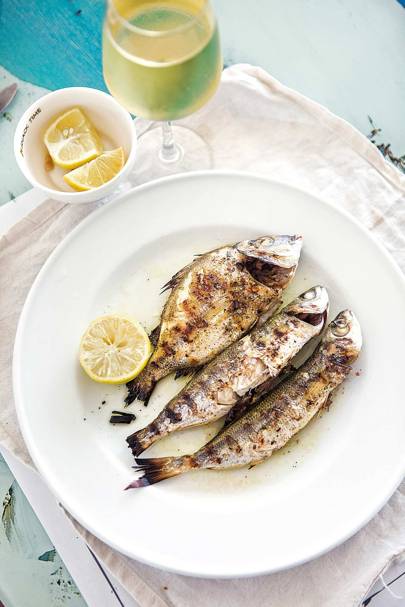
Sirocco restaurant at Paleochori, Milos
I went back to Skinopi in the early autumn, to a syrma just next to the one I had been in before. This time I had a neighbour, Christophoros, Skinopi’s premier citizen (he’d been away when I was there last), moving around in swimming trunks and flip-flops, tending to his boat, lending me an oven, bringing me fresh shrimp and grilled fish, the sun gleaming on the dome of his head.
Any other Greek island I’ve been to for more than five days usually involves seeing the same thing at least twice. Santorini, for example, has just a handful of mostly groomed beaches. Milos has more than 70. It also has catacombs second only in historical significance to Rome’s, the remains of an amphitheatre that once held 7,000, a pretty capital in Plaka with labyrinthine streets, a castle on a high summit, and archaeological, maritime, ecclesiastical, folk, war and mining museums. You move through monuments of stone and never see the same thing twice. Even the open-cast mine at Voudia will amaze you. It’s like a gigantic, multi-coloured mineral version of Chinese terraced agriculture.
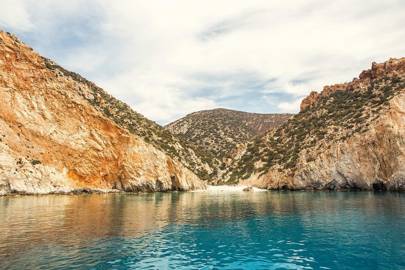
I went out to look at Milos again, starting with a motorbike and upgrading vehicles throughout my stay according to the remoteness of the destination. If the great bay were a mouth, the cape containing Skinopi would be its upper jaw. Here the island is at its most dense, with the harbour town of Adamas down around the molars and, going northwards, Tripiti, Plaka, the syrmata villages, the catacombs, amphitheatre and site of the Venus discovery. East along the north coast is one of the most startling natural events you might encounter: the narrow blue bay at Sarakiniko, its arms bone-white rock, a kind of petrified foam with undulations like bed sheets in the wind, and occasional eruptions of Dalí-style swirls. Near the water level, pirates’ chambers have been cut out of the stone. Further along, at the north-eastern tip, is serene Pollonia, which has Milos’ best hotels, some excellent harbour-side restaurants and the island’s only commercial winery, Kostantakis.
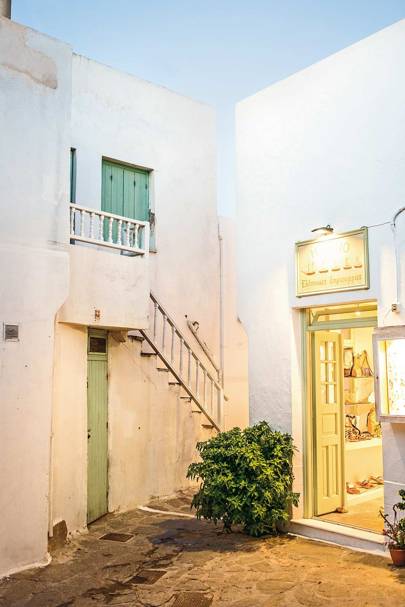
A shop in Plaka, Milos
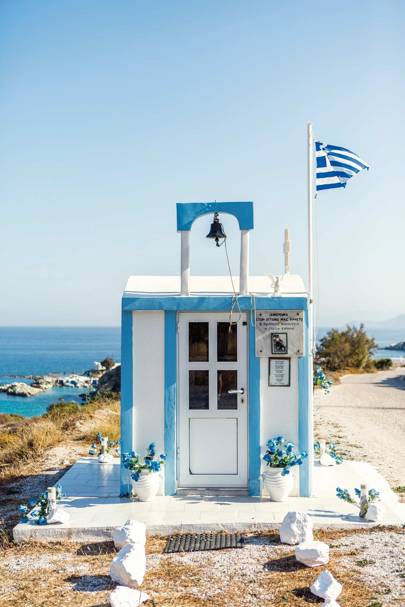
A tiny church in Milos
There are people who would cross continents for a beach. I am not one of them. But the beaches of Milos have, for me, a unique allure. You wake up wondering what they will offer. There is one, or more likely a dozen, for any taste. At Paleochori you can have lamb or fish cooked in the geothermal sand. Firiplaka is gold, purple, rose and white. My favourite was next to it at Tsigrado, which you lower yourself to by rope through a crevice in the cliff.
The experience of both road and beach becomes more exalted as you move into the wilder and emptier west. Beyond a certain point a four-wheel-drive is required, but the rougher the road, the more thrilling the vistas. I’ve heard that someone from the Metaxa brandy family has plans for a five-star hotel out here, but for now it’s completely undeveloped. In altitude and variety it is a kind of desiccated Big Sur, with gambolling goats and strewn crystals and obsidian thrown in. In the south-west corner at Kleftiko the track leads to the well-husbanded oasis of Agios Ioannis monastery. Below is a glorious beach with what seemed like three chambers, white-walled at the end, the water luminous, each stone an absorbing piece of jewellery. I was entirely alone.
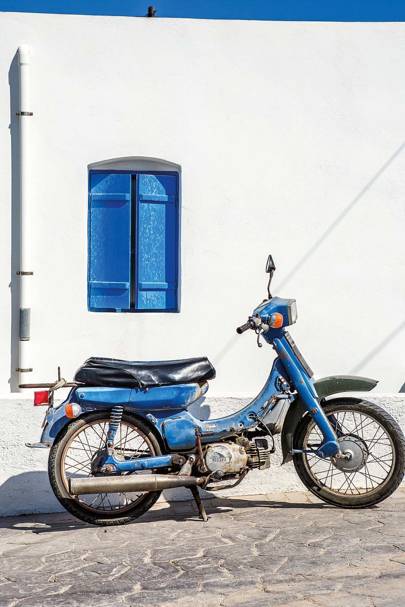
A motorbike in Mandrakia
I learned on this return visit that you cannot get the full impact of Milos unless you take in its circumference from the water. There is the swimming in turquoise bays you could not otherwise get to, the octopus tenderised in the boat’s wake that you will have for lunch, the air and light and camaraderie. But above all, it is the experience of rock that acquires a new dimension. I left Adamas on a Chrysovalandou catamaran at 9am. A little later Polychronis, the captain, saluted my neighbour Christophoros with a blast from a conch shell, calling him the ‘king of Skinopi’. We passed the syrmata villages, rounded the northern tip, headed east past Sarakiniko and then met the strange and austere hexagonal basalt columns of the Glaronissia islets. Some are like organ pipes, others like squat yeomen, still others like decapitated mushrooms.
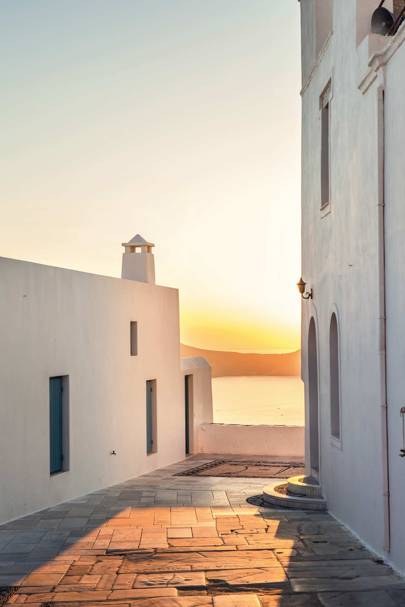
Panaghia Kortfiatissa church, Milos
The catamaran drifts in silence. It’s difficult to believe you are looking at something in nature. You sense the explosion that vaulted them from the sea. The feeling intensifies as you round the island through the day, the cliffs in their reds and yellows and blues and whites like immense abstract canvasses, encrusted rocks rising from the water stark as Giacomettis, massive white Moore-like forms with curves and ripples and holes. Then you round Vani on the north-western tip and turn into the harbour at sunset, passing towers of manganese and other volcanic rock in black, blue and green, patterned like snakeskin. The island has become a gallery. It is thought that a singer and sculptor named Alexandros, from Antioch, carved the Venus. Milos from the water appears like a monumental act of the imagination, something an artist would do if they were a god. Then, at twilight, you touch gently down at Adamas, the taverna lights calling you in.
WHERE TO STAY ON MILOS
The best Milos hotels and guesthouses I found were all in Pollonia: the intimate Tania Milos, the emphatically white, cave-like Salt and the more classical Melian. Just outside Adamas and close to Papikinou beach are the Santa Maria Luxury Suites. Serendipity has private villas and mansions on several islands, with concierge service and personal chefs. It can also get you an austere stone cube with a sensational view in Skinopi, but for a syrma search Airbnb or on antiparos-milos.com.
taniamilos.gr; doubles from about £65. +30 22870 41062salt-milos.com; doubles from about £95. +30 22870 41110 melian.gr; doubles from about £140. +30 22870 41150 santamaria-suites.gr; doubles from about £95. +30 22870 28123 serendipitygreekvillas.com +41 078 700 85 87
WHERE TO EAT ON MILOS
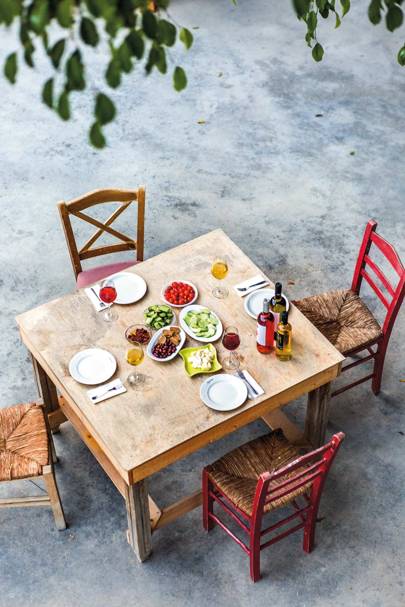
Kostantakis winery, Milos
Citizens of Milos resent the gastronomical distinction granted their neighbour, Sifnos. I did not have a poor or mediocre meal while here. The waterside taverna Medousa at Mandrakia (+30 2287 023670) was memorable as much for the setting as the food; Navagio in Adamas (+30 2287 024124), where chef Konstantines Papaioannou conjured a succession of brilliant cold seafood dishes after his oven broke; and above all, Armenaki in Pollonia (+30 2287 041061), where it’s best to allow chef/owner/sommelier Adonis Mavroiannis choose for you. I would not otherwise have encountered the extraordinary roe of grey mullet, the sea urchin, and the cleansing properties of courgette carpaccio.
GETTING TO MILOS
For more information on Greece, visit discovergreece.com. Aegean Airlinesflies from London to Athens direct three times daily year-round and on to Milos and more than 30 more Greek destinations. For four-wheel-drives to rent, visit milosrent.gr. Book a catamaran trip at sailcatgreece.com.
This feature first appeared in Condé Nast Traveller June 2017
Source: cntraveller.com



















